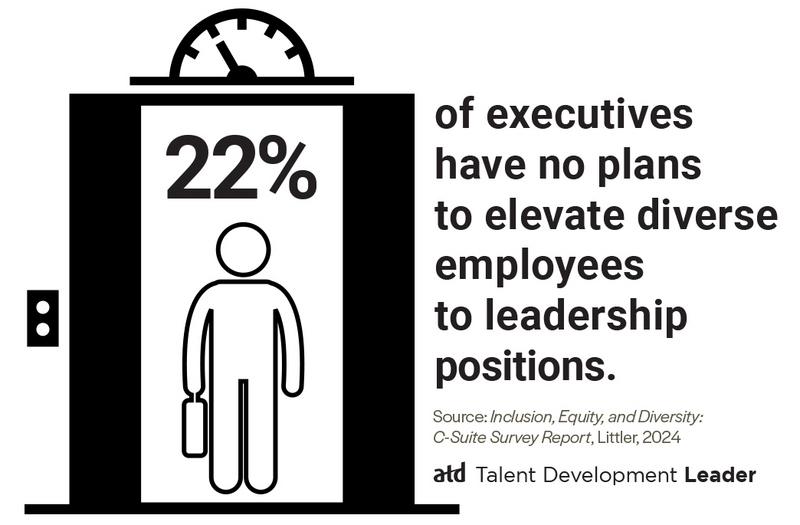Talent Development Leader
What Can Fill Leadership Diversity Gaps?
Consider a formal sponsorship program to promote DEI.
Mon Mar 25 2024

While headlines suggest a decrease in support for diversity, equity, and inclusion initiatives, a report from Littler released in January found that many employers have deepened their commitment to DEI. In Inclusion, Equity, and Diversity: C-Suite Survey Report, more than half of the 320 respondents said their organizations have expanded DEI programs during the past year.
But even as companies maintain their investment in DEI, many aren’t working to increase diverse representation among their leadership ranks. Twenty-two percent of executives told Littler they have no plans to elevate diverse employees to leadership positions, and 27 percent reported no mentorship opportunities geared toward underrepresented employees.
HR research and advisory firm McLean & Company notes that there is often a disconnect between talent management programs that build future leaders and an organization’s commitment to DEI. The firm’s blueprint, "Build an Employee Sponsorship Program," advises HR and talent development leaders to address the gap with formal sponsorship programs.
"Leadership representation gaps will not resolve themselves and individual-level solutions are not enough for meaningful change to happen," says Elysca Fernandes, director of HR research and advisory services at McLean & Company, in a press release.

Even though informal sponsorship relationships often develop organically in organizations, they typically perpetuate existing barriers to advancement such as affinity bias, McLean & Company found. However, formal sponsorship programs with specific goals can target those barriers and provide career path clarity.
To help TD and HR leaders design and implement a formal sponsorship program, McLean & Company recommends the following steps.
Gauge the need for sponsorship. The TD and HR functions should assess both the need for formal sponsorships and the organization’s readiness. Identify key stakeholders and prioritize potential employees who are prime candidates to become a sponsor or a recipient of a sponsor.
Design the sponsorship program. Start with defining expectations and developing selection criteria. Next, decide how to match participants, outline milestones, and review constraints that affect results. Companies should take this time to explore potential technology solutions they can use to execute the program.
Implement and monitor the program. Develop an action plan and communication plan as well as a strategy for risk mitigation. After selecting and matching participants, provide them with training and other resources to facilitate the sponsorship engagement. Monitor and evaluate the program regularly to make any necessary updates to its design and delivery.
"Sponsorship cannot be a one-size-fits-all solution, as each employee segment has a distinct employee experience and faces different barriers to advancement,” Mclean & Company reminds executives. “Using an intersectional lens and customizing the sponsorship program to reflect the unique needs of each employee segment is critical for maximizing the benefits of participation.”
Read more from Talent Development Leader.
